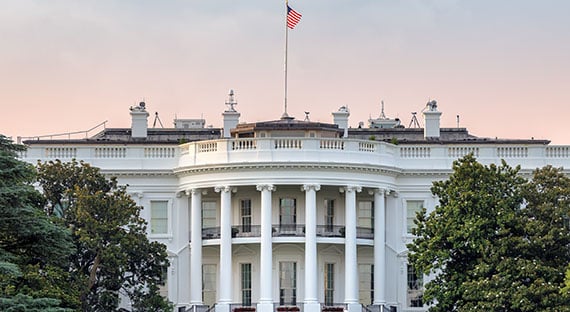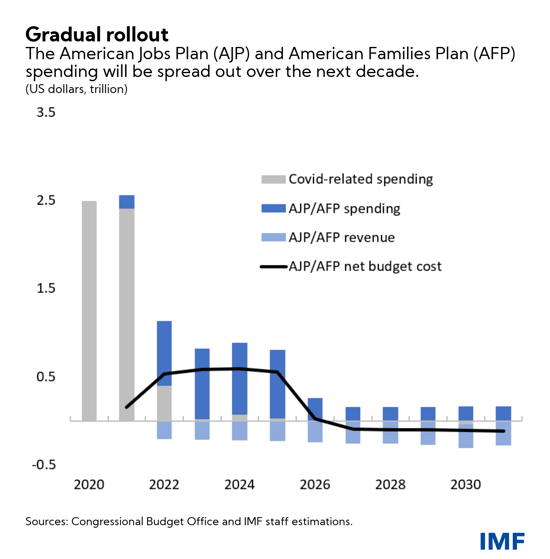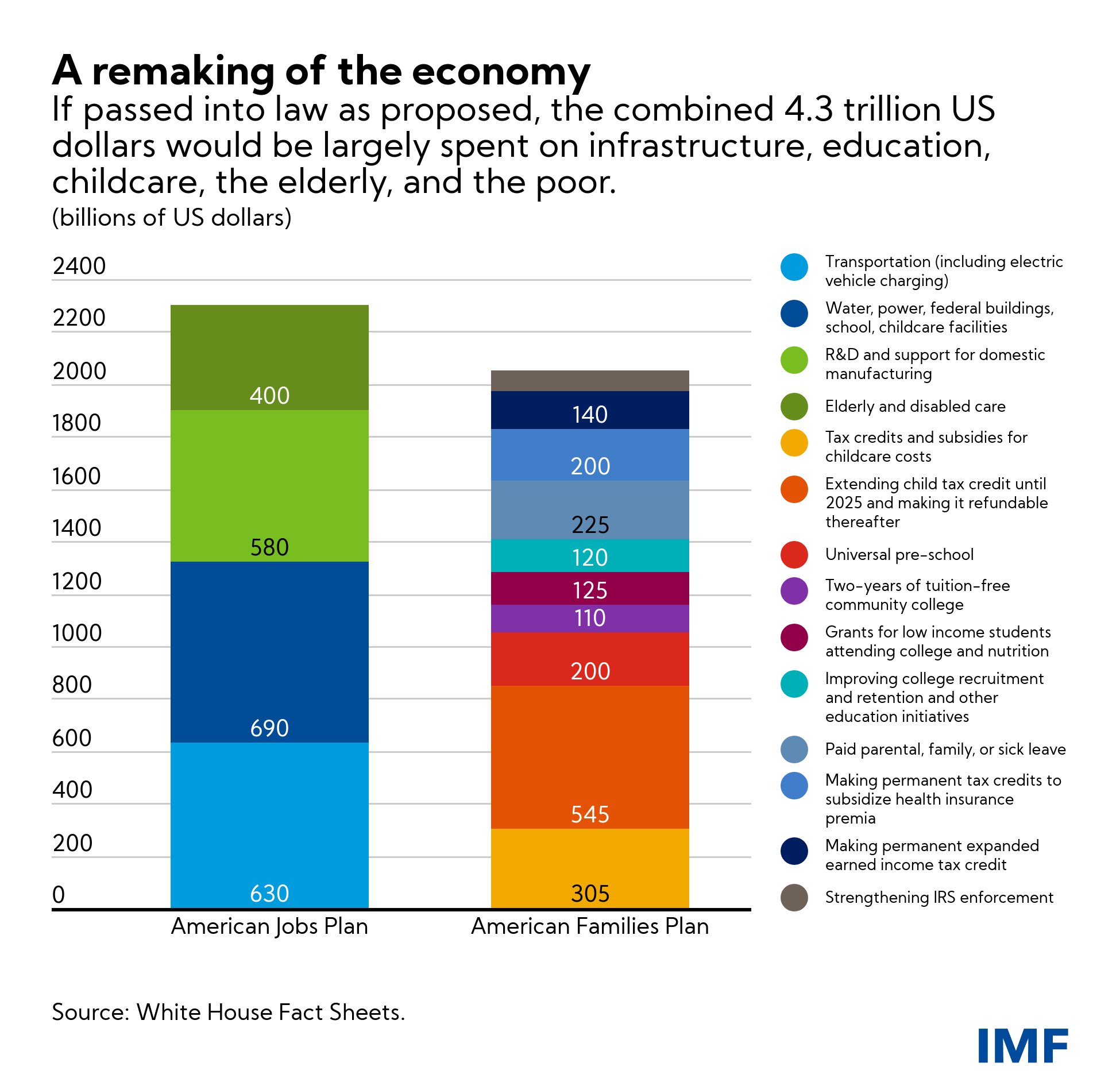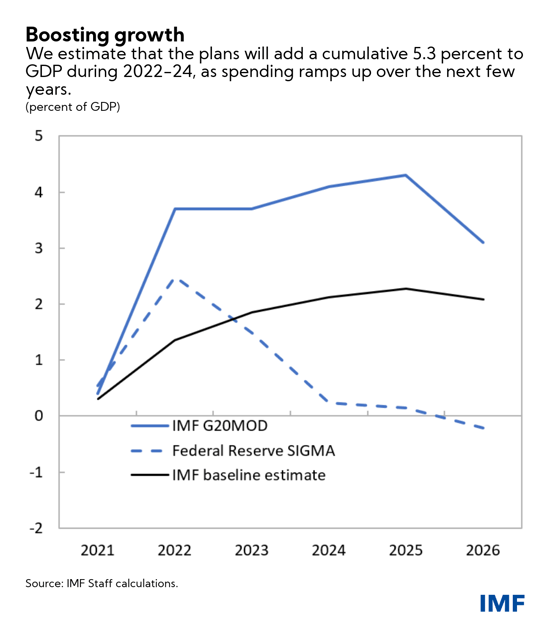
The White House in Washington, DC. The Biden administration’s proposed spending plans are expected to boost the economy and raise GDP. (photo: lucky photographer by Getty Images)
Boosting the Economy: The Impact of US Government Spending Plans
July 1, 2021
Despite the tragic loss of life and immense challenges brought on by the pandemic, the US economy is making a remarkable recovery. The Biden administration’s proposed spending plans will add momentum, raising GDP by more than 5 percent from 2022 to 2024, and will create a lasting impact by increasing productivity and labor force participation.
Related Links
The economic impact of the American Jobs Plan (AJP) and American Families Plan (AFP) was the focus of the IMF’s annual economic and policy review of the United States. After completing discussions with the country’s authorities, IMF staff issued a statement today summarizing their conclusions, which will be discussed by the IMF’s Executive Board on July 16.
The AJP and AFP will increase spending and tax expenditures by US$4.3 trillion over the next
decade (about 18.7 percent of 2021 GDP), although the final size and
composition of these plans will be subject to negotiation in the US
Congress. The spending would be partly financed by raising taxes on
corporate profits and high‑income households.
Addressing key challenges
The proposed plans are designed to address a range of challenges that have held back the economy. Many of these challenges have been magnified by the pandemic, which has worsened income inequality and had a disproportionate impact on historically marginalized groups. In this context, the AJP and AFP would make substantial investments in both physical and human capital to help alleviate these disparities and create greater opportunities for economic advancement. Significant investments in infrastructure, research and development, education, childcare, and in-home care would increase productivity and support participation in the labor force. The proposals for a refundable child tax credit, expanded earned income tax credit, and expanded healthcare coverage would reduce poverty and support lower-income groups.

The output impact
Overall, IMF staff estimate that the AJP and AFP will add a cumulative 5.3 percent to the level of US GDP during 2022-24, as spending ramps up over the next few years. This estimate takes into account how different types of government spending have different ‘fiscal multipliers,’ meaning that they affect the economy in distinct ways and to varying degrees. For example, cash transfers to households, such as the child tax credit, are likely to boost spending in the economy, while childcare support may also increase participation of parents in the labor force. Spending on the construction of physical infrastructure, research and development, and education may raise productivity over a longer horizon.
IMF analysis also shows that there is some uncertainty around the exact
size and timing of these economic effects, which is reflected in the range
of estimates produced by economic models, including the IMF’s G20MOD model
and the Federal Reserve’s SIGMA model.
The inflation and debt sustainability implications
Inflation has been at high levels in recent months, but it is expected to decline over the rest of this year, as temporary inflationary factors subside. Starting next year, the proposed fiscal plans are expected to add moderate inflation pressures. The fiscal packages will be rolled out gradually over a ten-year window and are expected to boost the supply capacity of the economy, which will help alleviate concerns that the boost to demand will fuel underlying inflation. Overall, inflation is forecast to be around 2.5 percent by end-2022. The US has adequate fiscal space to implement these spending plans, although additional steps will be needed over the medium term to bring down public debt.
An inclusive recovery
The US recovery must be inclusive, and its benefits should be shared by all of society. As the pandemic recedes and the economy rebounds, it is more important than ever to support communities that have been historically underserved, marginalized, or affected by poverty. The proposed spending and tax changes will benefit female-headed households, who make up a disproportionate share of the poor, as well as Black and Hispanic families. Research has shown the importance of childcare support, universal pre-school, and generous “work-based” tax credits in supporting more women, minorities, and lower income workers to participate in the labor force. Investment in much-needed physical infrastructure should also benefit marginalized communities. The boost to productivity that these investments will produce can support more jobs with sustainably higher wages, in a more equitable economy.


